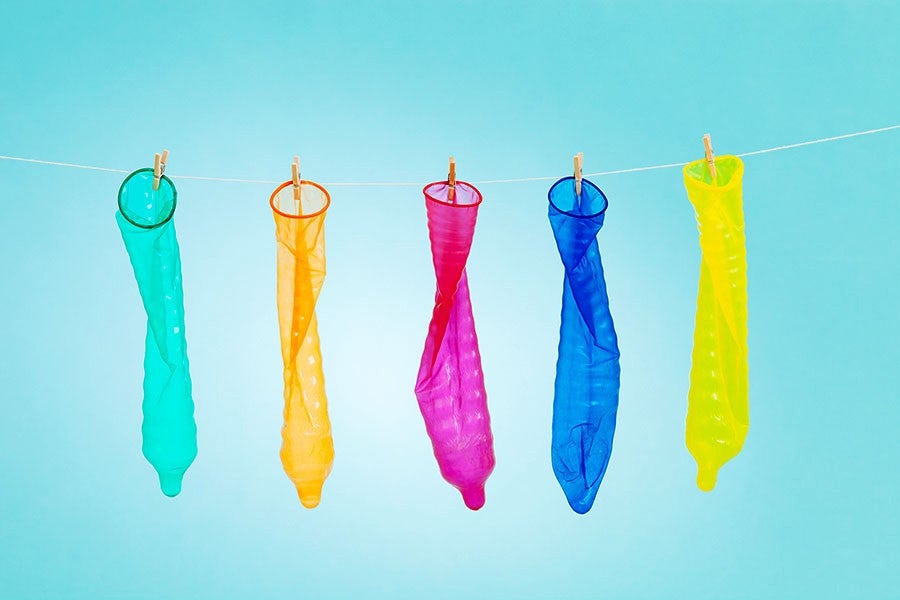Late last week, the CDC tweeted out a PSA to not reuse condoms:
We say it because people do it: Don't wash or reuse #condoms! Use a fresh one for each #sex act. https://t.co/o3SPayRf9m pic.twitter.com/AwkPqE9YMl
— CDC STD (@CDCSTD) July 23, 2018
And once we’d stopped facepalming ourselves right through a wall, we stopped to wonder: Who the hell is really doing this? And how are there so many of them that the country’s largest health protection agency felt the need to get involved? With all due sense of regret and apprehension, we did some digging.
Who Reuses Condoms? No Seriously, Who?
If you don’t put any thought into it (which you might not, if you’re about to bangarang), cleaning out an old condom kind of makes sense, if condoms are hard to come by and you’re strapped for cash, at least. This, says Nicole Prause, a neuroscientist who studies human sexual behavior, might explain why around two percent of American men and women reported having reused a male condom that wasn’t designed to be reused. “It’s more common in less-affluent areas, suggesting it’s strongly related to financial concerns for most who reuse,” says Prause.
So despite Twitter’s reaction to the CDC’s tweet, this isn’t just another ploy by Big Condom to keep us buying new dick sleeves. (The jury’s still out on whether they were behind the Condom Challenge, both 2015 and 2018 versions.)
https://twitter.com/pardergral/status/1021879966374326272
Now, for those who do reuse their condoms for financial reasons, please consider the following two points:
- Free condoms are available almost everywhere, especially in the U.S. Here’s a website that will give you all the places to find them near you — go stock up on a bunch, for all the sex at least one of us is having.
- If you’re really concerned about money, consider that buying another pack of condoms is much, much, much cheaper than a kid, or even an STD, so make sure to stop and do that math next time you’re getting hot and heavy. The same applies for those who might reuse a condom for “environmental” reasons — a single human being even existing is far worse for the environment than a multipack of MAGNUMS.
How Do You Even Reuse a Condom?
Prause explains that, while it’s possible to put on an unrolled condom — especially if done while semi-erect — she doesn’t know of any data describing how such recycled condoms are typically handled between uses, “such as how often it’s rinsed, cleaned with surfactants, allowed to dry or the time between reuse.”
So while data is available that people are reusing condoms, there’s no data on whether people are, say, rinsing them out and hanging them up to dry afterward, or maybe just flipping ’em inside before going back to poundtown. Frankly, the experts have no idea how people are reusing condoms, they just know that you shouldn’t be.
What Are the Risks of Reusing Condoms?
It should — should — go without saying that reusing condoms is a bad idea, although according to Aine Collier, author of The Humble Little Condom: A History, it’s taken people a while to get smart about condom reuse. “Early brothel owners often told their ‘girls’ to gather up used condoms when customers left to be washed and resold,” she says, adding that back then, animal-skin condoms were much stronger (though less effective) than today’s. “The first rubber condom was so thick, it was advertised as something the buyer would only need one of throughout his life.”
But today’s condoms are tested and built for single-use only. In short, unlike that masturbatorial gym sock under your bed, condoms aren’t built to last. “Most condoms are made of either latex or polyurethane type rubber, very thin and typically tested only with single-use scenarios,” says Steve McGough, an associate professor of clinical sexology at The Institute for Advanced Study of Human Sexuality. “When they’re unrolled, applied and used, the rubber materials are stressed and stretched. Plus with latex condoms, the material will weaken even more when dried out, so using it again increases the odds of it breaking.”
Prause agrees, adding, “Condoms can have tears that you cannot see that cause it to be less effective. You might rinse it, but you won’t see it tear, which would render it compromised and unusable.”
The whole point of using a condom is that they’ve been scientifically tweaked and tested for years to block sperm — and everything else crawling on your dick — from spreading to your partner. That’s why directions on disposing of the condom after use are included in the whole condom experience: When you’re done, you pinch the tip and unroll, effectively keeping all the juices within the latex walls. You don’t wash them, and for the love of everything holy, you don’t “just suck everything out of them.”
i just suck everything out of em. don’t even need to wash em
— illy boo-cean ? (@IllyBocean) July 25, 2018
Not only will a reused condom fit too loosely around your dick, allowing any microscopic STDs/STIs or sperm to leak out, there’s a good chance it just won’t stay on — imagine using plastic grocery bags as dishwashing gloves and you’ve got the general idea.
Also worth noting: Merely washing the condom out might kill off the sperm, but not any present STIs, “which would potentially transfer the STI to the next partner,” says McGough. A brand new condom’s effectiveness at preventing disease or pregnancy is only a measly 85 percent as it is — reusing will only lower those odds..
Basically, unless you’re living in a remote village in Kenya or India, where occasional condom shortages force villagers to recycle condoms as a last resort, there’s no excuse to reuse condoms. So please keep them in your wallet, and away from the clothesline.

